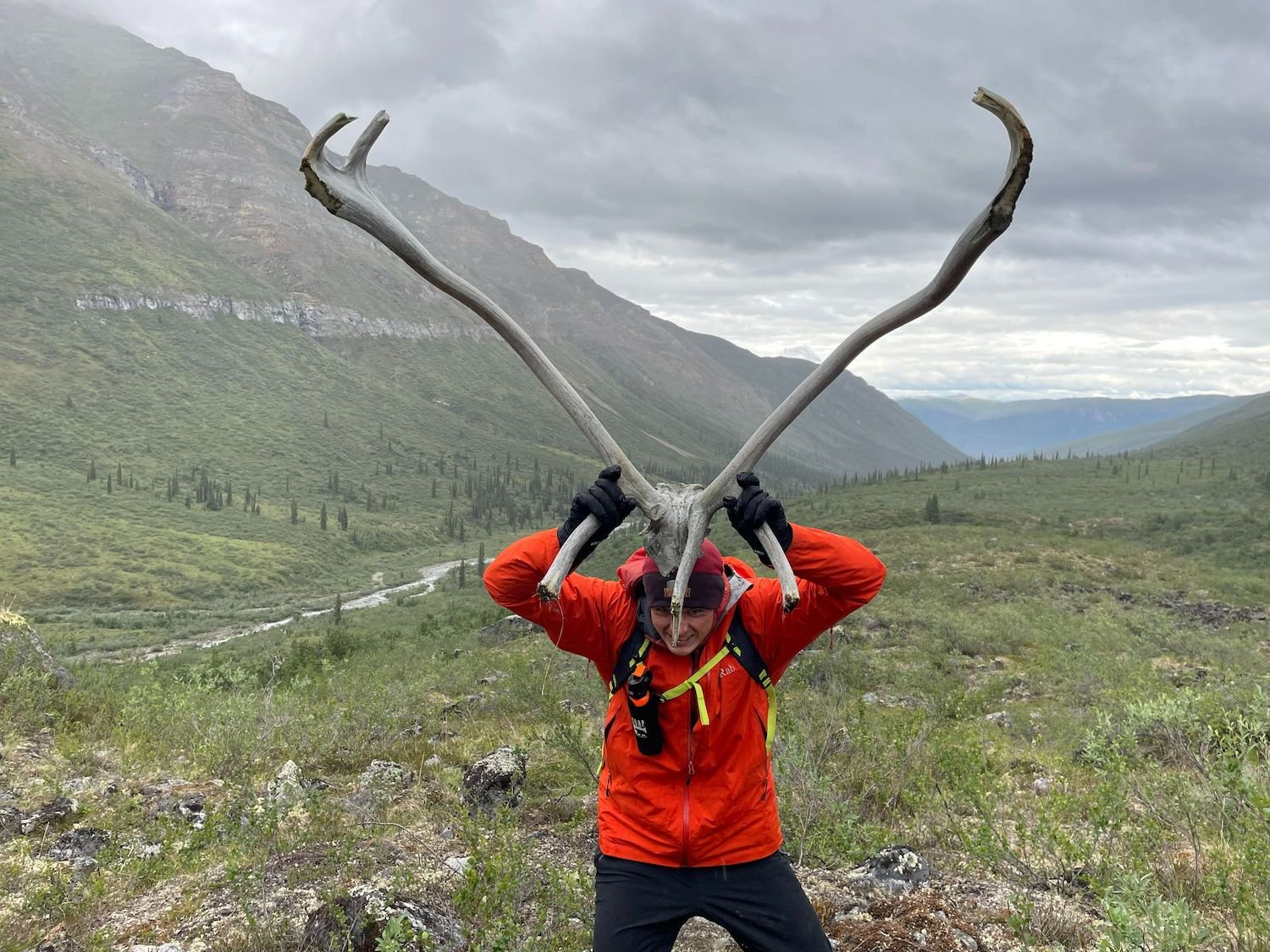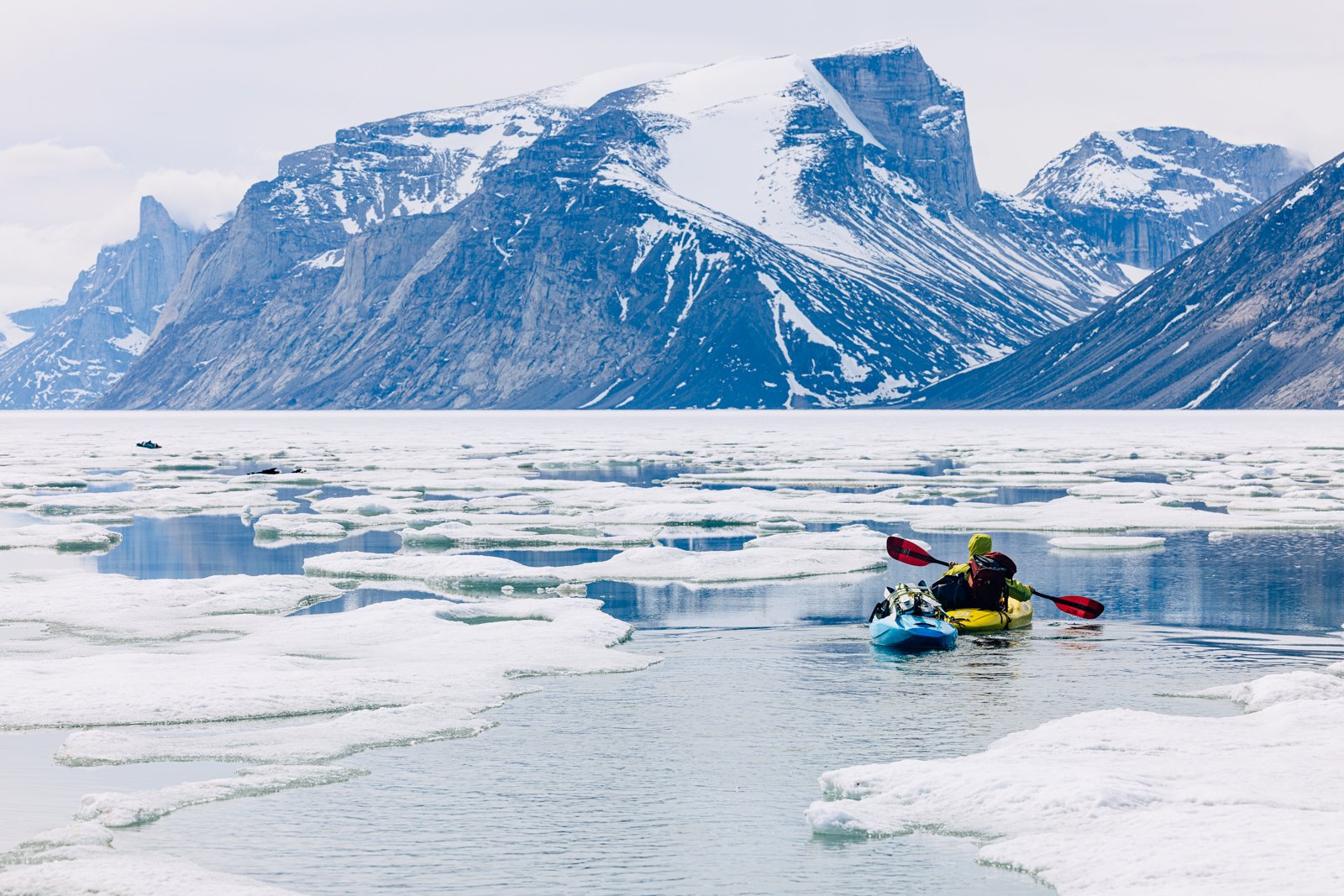The Line is the monthly newsletter of the American Alpine Journal.
Bivouac on the southwest face of Ingolfsfjeld during the ’75 expedition. Photo by Jim Davenport.
GREENLAND’S GIANT MYSTERY WALL
The huge southwest face of Ingolfsfjeld, with 63 pitches of climbing, after a snowstorm. Photo by Steve Chadwick.
In the early to mid-1970s, one of the great challenges of arctic climbing was the southwest face of Ingolfsfjeld, an enormous wall 120 kilometers northeast of Tasiilaq on Greenland’s east coast. Visible from the sea, the peak was first climbed by its northeast ridge in 1971, by a Croatian duo, but the biggest face—rising at least 1,200 meters—remained unclimbed despite several attempts.
In 1975, a six-person British expedition finally succeeded, with three of the climbers making the final push to the summit. The resulting route had around 2,000 meters of climbing and was graded ED+ UIAA VI+ (5.10) A3, an extremely difficult wilderness wall for the era. Yet the climb has been largely forgotten, and until this year, no account had been published in the AAJ.
Expedition member Steve Chadwick has described this remarkable expedition at length in a previously unpublished article, now available at the AAJ website, along with photos, a topo, and a pitch by pitch summary of the 63-pitch climb, which likely has never been repeated. (The last known attempt on any route up the mountain was in 1986!) An overview of the 1975 climb, written by senior editor Lindsay Griffin, will appear in AAJ 2023, which will be mailed in late summer.
Introduction to Keith Myhill’s pitch-by-pitch description of the route, which totaled 6,640 feet of climbing. A link to the full description is in Steve Chadwick’s article at our website.
MINI-EPIC(S)
Mark Allen starts the team’s ascent of Chimaphila (470m, IV AI4) on Black Spire in the North Cascades. Photo by Jesse Charles.
Winter climbing is hard on climbers—and on their approach vehicles. Last winter, Mark Allen, Jesse Charles, and Seth Keena snowmobiled about 25 miles along closed Highway 20 in the North Cascades to make the first ascent of the east face of Black Spire by a varied ice line. Late in the day, they skied back to the unplowed road and mounted their sleds for the ride back to the car. Soon, the troubles began.
Keena opens his report for the upcoming AAJ 2023 with a description of his body slamming into the handlebars of his 1999 Yamaha Phazer. “I had acquired my snow machine for a bargain price, with the caveat that it had an ‘intermittent electrical issue, but not that big of a deal.’” he wrote. “Now, while cruising at 55 mph, the engine and lights had cut off, bringing sudden darkness and deceleration.”
Keena restarted the sled and followed his partners toward the plowed road. “Eventually we all made it back to Mark’s truck at the end of the plowed highway,” he wrote. “But, once again, we quietly faced the power of winter when we discovered the truck’s battery was dead.”
At least their phones still worked. A pleading call summoned help. Said Keena: “A friend is someone who, at 11:30 p.m., leaves their warm bed and drives to the end of the highway to jump-start your dead battery: Thank you, Patrick Murphy, you are a true friend.”
Without apparent irony, they called the new route Chimaphila (“winter lover”). Read Keena’s full AAJ report here.
Join the Club—United We Climb.
Get the AAJ Sent to You Annually
Partner-level members receive The American Alpine Journal book every year. Documenting mountain exploration and the year’s most significant ascents through first-person reports and photos, it’s an essential historical record and a feast of inspiration.
Rescue & Medical Expense Coverage
Climbing can be a risky pursuit, but one worth the price of admission. Partner-level members and up receive $7,500 in rescue services and $5,000 in emergency medical expense coverage. Looking for deeper coverage? Sign up for the Leader level and receive $300k in rescue services.
DENALI’S EAST BUTTRESS:
A 60-YEAR RETROSPECTIVE
Some years ago, Peter Lev, one member of the team that made the first ascent of Denali’s east buttress, published a photo-filled retrospective of the expedition. Lev summited on May 25, 1963, along with Rod Newcomb and Al Read. The other teammates were Warren Bleser, Jed Williamson, and Fred Wright. Here, we bring Lev’s images to light with a gallery of the marvelous photos from his piece. (Click on the images for captions.) You can download the complete retrospective in PDF form by following a link at the end of Read’s feature article in the 1964 AAJ.
Shop the AAJ Collection
Sign Up for AAC Emails
The Line is the newsletter of the American Alpine Journal (AAJ), emailed to more than 80,000 climbers each month. Find the archive of past editions here. Interested in supporting this online publication? Contact Billy Dixon for opportunities. Suggestions? Email us: [email protected].














































































































